Losing a tree diseased by hypoxylon canker
A few days before Christmas, the front garden endured a major change: a fatally diseased live oak near our front door had to be removed. I’d had an arborist out the week before to give me a bid on general tree trimming, and he immediately spotted the sloughed-off bark and telltale whitening of hypoxylon canker affecting this tree.
I’d been concerned about the tree myself for the past year, and consulted with another arborist last spring, but he dismissed the sloughed-off bark as just a normal process. I had my doubts, and my fears were confirmed with the diagnosis of late-stage hypoxylon canker, a fungal disease I’d never heard of. Oak wilt, a live-oak killer here in Texas, was the only tree disease on my radar. Hypoxylon, I learned, lurks in most healthy trees, waiting for an opportunity — a tree weakened by drought or other stress — to attack.
With no cure and a danger of the weakened tree falling on the house, we had the tree removed. We have plenty of live oaks to spare, but what a shock to see open sky where the tree once leaned over the house, filtering sunlight. Aesthetically, it’s OK. The remaining trees frame the entry, and the Japanese maple has new prominence. But I’m worried that, come summer, the shade-loving maple and foundation shrubs will have too much sun. I can only wait and see, hoping that their location on the north side of the house, with shade remaining on the west, will protect them.
I’m worried for several of my other trees too, which also show early signs of the canker. Healthy trees can resist the fungus, and the arborist recommended a deep-root fertilizing in the spring to give them a boost. We’ll do that and keep a close eye on them, especially if (when) drought returns. Meanwhile, we’ll have the stump ground out soon, and if the oak sprouts that colonize this little lawn stop popping up, I’ll replace the grass with Texas sedge for a no-mow, evergreen groundcover.
If you live in Central Texas, you may be curious to learn more about hypoxylon canker yourself. Here is some information my arborist shared with me from Texas A&M AgriLife Extension.
I welcome your comments; please scroll to the end of this post to leave one. If you’re reading this in a subscription email, click here to visit Digging and find the comment box at the end of each post.
All material © 2006-2016 by Pam Penick for Digging. Unauthorized reproduction prohibited.


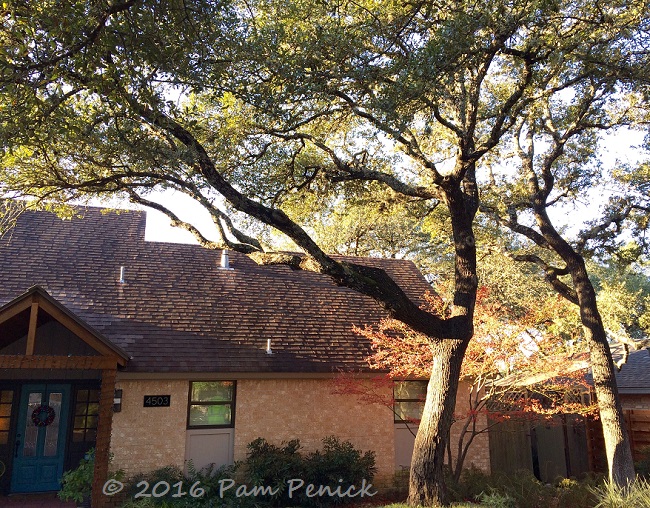
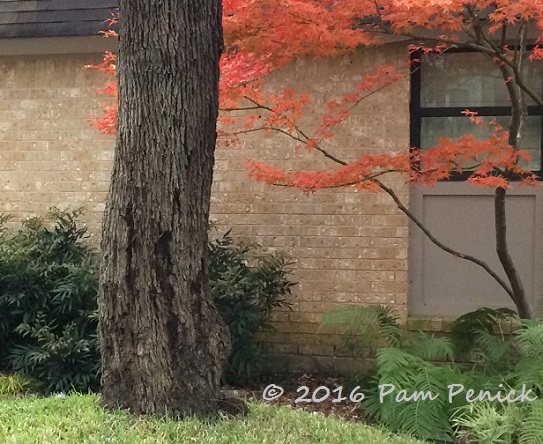
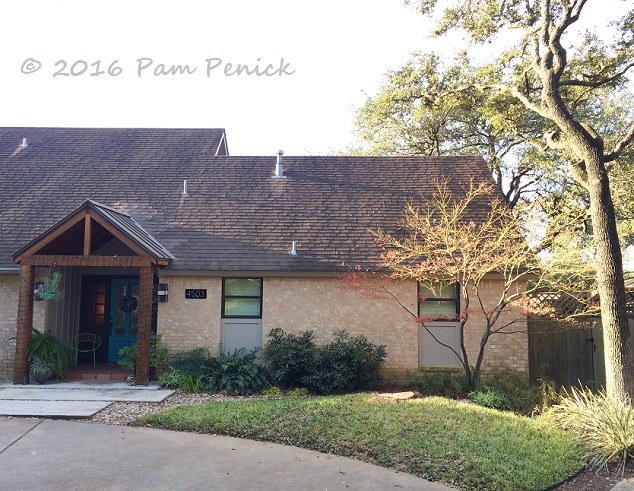
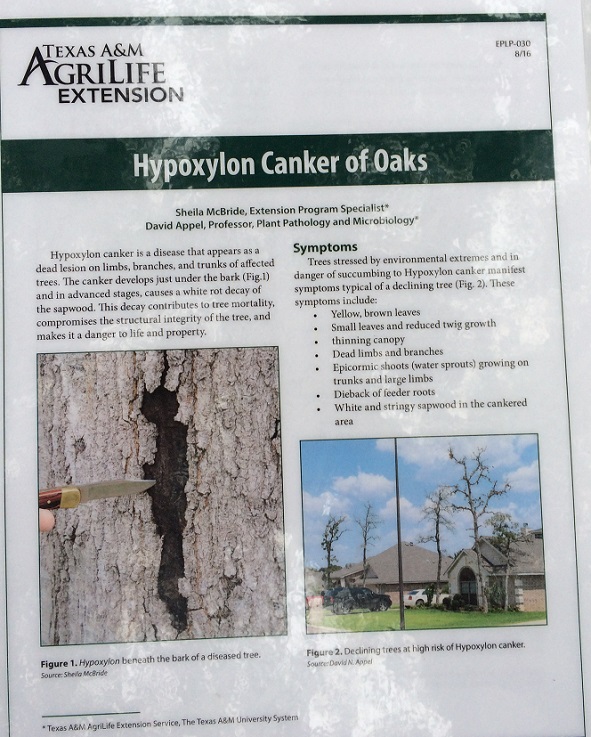
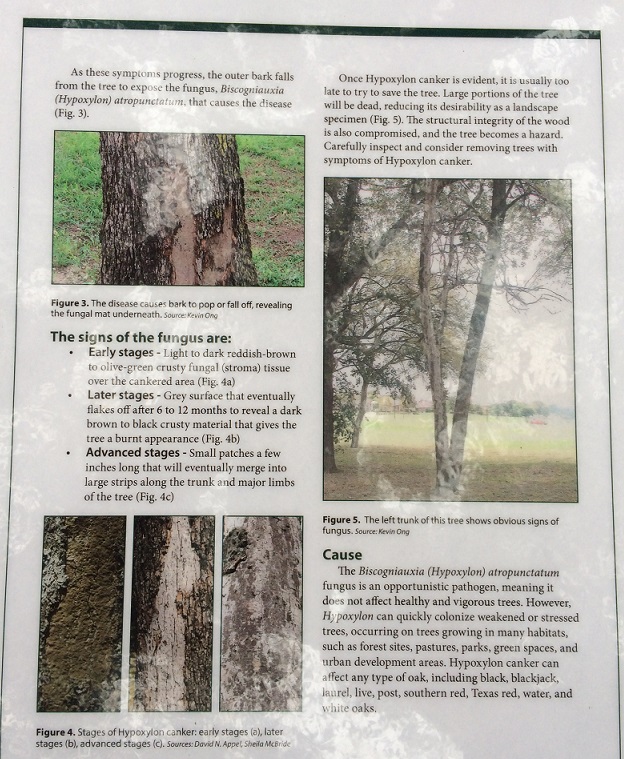
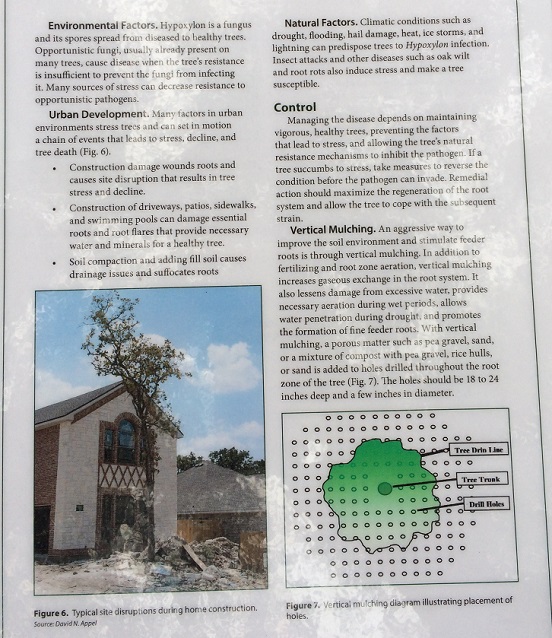
Sorry to see you lost that Oak. Drought has killed many trees here, but not the native Oaks–yet, anyway.
Any possibility one of the little oak sprouts becomes its replacement?
I’m not totally convinced it was drought that stressed this one, as it’s in a part of the yard that gets watered in summer. Other oaks that get much more occasional water are doing fine. But you never know. It might have been stressed by something else, and then the drought hit it again.
I don’t plan to replant a tree here. We have dozens of mature live oaks on our average-sized lot. I’m just hoping that the now-prominent Japanese maple can handle the increased sun and will play a starring role. —Pam
That’s terrible. I’m sorry you lost such a lovely tree. You know I always drool over your live oaks. Although, looking at it on a larger screen, now, the front of the house doesn’t look any worse for the loss. As you said, the Japanese maple gains a new prominence.
I hope the plantings can handle the extra light. If not, it will just be an opportunity to try something new. I hope the deep fertilizing gives the other affected trees the boost they need.
I like your positive spin on things, Evan. Thanks for the commiseration too! —Pam
So sad to lose a big tree. I have noticed one of our trees looking as though it is on its way out. Drought, hail damage may be playing a big part but I will check the bark for signs of this disease. Bark flaking off was the cause of the loss of our pomegranate tree. I wonder if it was the same disease.
Could be, Jenny. Our arborist said hypoxylon is common in many kinds of trees. —Pam
I’m sorry to hear that you lost a tree, Pam. For me, losing a tree is a little like losing a family member. I still remember losing a mature Arbutus unedo at our old house to the pathogen responsible for sudden oak death – 2 weeks after I noticed something was amiss, the tree was dead. I hope you can avoid the canker becoming a problem with any more of your trees.
I sure hope so too, Kris. We’re going to do everything we can for them. —Pam
I’d heard of hypoxylon canker before, but didn’t take it seriously. With my live oaks, I’d always worried about oak wilt. After reading your post, I now know I need to take hypoxylon canker more seriously. My hope for you is that this is the only tree impacted and that your beautiful maple continues to thrive.
Exactly, Laura. I was always concerned about oak wilt, but it ended up being something I hadn’t heard of that killed this tree. —Pam
Sorry about the tree. “Root flare exposure” often comes up in tree health discussions in Dallas. Nurseries often grow trees with soil too high on the trunk and then they are planted too deeply. Over time, soil and organic matter can build up around the trunk. They say this can cause decay on the trunk and affect the health of the tree, the same way mulch volcanos are bad for trees. You should see the trunk flare out where it meets the ground. My guess is that your tree had close to a foot of dirt and organic matter above the flare. There are companies in Dallas that have special tools for exposing the root flare without damaging the roots. I would look for a company in Austin that performs this service if you have other trees that do not have an exposed flare. I think this could benefit your trees more than deep fertilization. Good luck. Looking forward to seeing what you do with this spot.
Our arborist did point out one of our trees that needs more of its root flare exposed, but he didn’t indicate that was a problem with the diseased one. The weird little berm it was sitting in is one of several in our front yard (our next-door neighbor has them too) that contain live oaks, and that were apparently preserved during construction of the houses. The whole neighborhood is part of a live oak forest. I don’t think that any of our live oaks were planted as specimen trees.
That said, you are absolutely correct that piling up soil or mulch over a tree’s natural root flare is harmful to the tree. Your comment reminds me that I need to go uncover the one our arborist pointed out. And thanks for the tip about the companies that offer this service. —Pam
I sympathize with your tree loss, and hope that your Japanese maple will adjust to its new sunnier exposure. We lost a massive white oak 3 years ago that we had to have taken out. It apparently had been stressed by a hurricane 17 years earlier and it took that long for the rot to spread inside and require its removal. I had sasanqua camellias, a maple, oakleaf hydrangeas, and many hellebores in its shade. All were stressed a bit that first summer of full sun from early morning to mid-afternoon. A big change from dappled shade! But they all did adjust, as did I to planting in full sun in that area, and now those plants look SO much happier. Less root competition and more sun actually seems to have been what they needed. Raleigh NC zone 7B
That’s encouraging to hear, Marilyn. Thanks for sharing. —Pam
Any chance you could share who your arborist is? I have some cedar elms that need to be looked at and wasn’t happy with the last company I used.
I would love to share a referral with you and anyone else in Austin, Peter, and if you tell them I referred you, I’ll get a discount on future tree trimming. 🙂 I used Davey Trees on the recommendation of a friend, and I am very happy with their work. They employ trained arborists, are insured, were careful with the house and garden, and cleaned up completely. Ask for Pablo, and please do tell them I sent you! —Pam
Sad that you lost the tree, and from the surrounding irrigated garden, it wouldn’t seem that drought stress was the real cause. We worry about our native Quercus agrifolia Coast Live Oaks here too, it seems like there are so many potential ways to lose one. Fortunately none in any client’s gardens seem impacted by Sudden Oak Death from Phythopthora here in Berkeley, but it is present everywhere. I discovered one Live Oak on a job site that had had 2 feet of fill soil piled over its root flare to create a wider flat area adjacent the house, and removed a tree well of 3 foot diameter to give it air again. It amazed me how the tree didn’t seem affected, and it had been this way for at least 5 years.
Yikes — two feet of fill soil on top of the flare? I’m surprised it survived. I bet it’s breathing a sigh of relief now. —Pam
Thanks for your blog! I’m concerned (freaked actually) about my 16 lives oaks. They look ok but I’m wondering about the deep fertilizing you mentioned. Is that something you can do yourself or something you need to get and arborist to do? Thanks for your help with this.
Mark Barber
It’s something an arborist would need to do, I believe. He talked about injecting the fertilizer deep into the soil. You might check with Davey Trees (that’s who I used) for more info. Good luck with your trees! —Pam